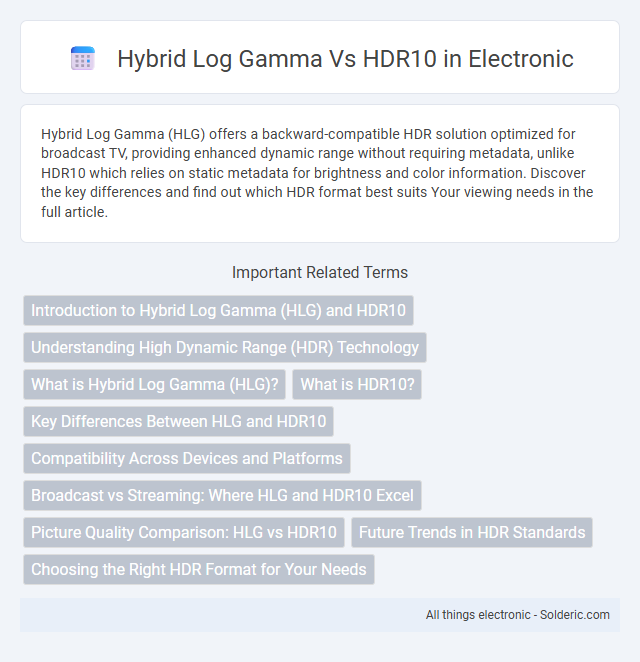Hybrid Log Gamma (HLG) offers a backward-compatible HDR solution optimized for broadcast TV, providing enhanced dynamic range without requiring metadata, unlike HDR10 which relies on static metadata for brightness and color information. Discover the key differences and find out which HDR format best suits Your viewing needs in the full article.
Comparison Table
| Feature | Hybrid Log Gamma (HLG) | HDR10 |
|---|---|---|
| Standard Type | Broadcast HDR standard | Open HDR format |
| Dynamic Metadata | No | Yes |
| Peak Brightness | Up to 1,000 nits (typically) | Up to 1,000-4,000 nits |
| Color Depth | 10-bit | 10-bit |
| Compatibility | Backward compatible with SDR displays | Requires HDR-compatible devices |
| Usage | Live broadcasts, streaming | Streaming, UHD Blu-ray, gaming |
| Developed By | BBC & NHK | Consumer Technology Association (CTA) |
| Licensing | Royalty-free | Royalty-free |
Introduction to Hybrid Log Gamma (HLG) and HDR10
Hybrid Log Gamma (HLG) is a high dynamic range (HDR) standard developed by the BBC and NHK designed for broadcast TV, enabling backward compatibility with standard dynamic range (SDR) displays by combining a gamma curve with logarithmic encoding. HDR10, an open HDR format introduced by the Consumer Technology Association, uses static metadata to define brightness levels and supports up to 10-bit color depth and a peak brightness of 1,000 nits or more. While HDR10 requires metadata for tone mapping on compatible displays, HLG avoids metadata, making it suitable for live broadcasts and streaming services.
Understanding High Dynamic Range (HDR) Technology
Hybrid Log Gamma (HLG) and HDR10 are key HDR standards enhancing visual content by expanding brightness and color range beyond standard dynamic range (SDR). HDR10 uses static metadata to optimize each scene with peak brightness up to 1,000 nits and 10-bit color depth, widely supported in consumer displays. HLG, developed by BBC and NHK, combines SDR and HDR signals without metadata, enabling seamless broadcast compatibility with HDR-capable TVs for live content and dynamic scenes.
What is Hybrid Log Gamma (HLG)?
Hybrid Log Gamma (HLG) is a high dynamic range (HDR) standard developed by the BBC and NHK designed to be compatible with both SDR and HDR displays without metadata. HLG uses a nonlinear electro-optical transfer function combining gamma curves for low luminance and a logarithmic curve for high luminance, enabling improved contrast and brightness in broadcast environments. Unlike HDR10, which requires static metadata for tone mapping, HLG simplifies live broadcasting by eliminating metadata dependency while maintaining enhanced image quality.
What is HDR10?
HDR10 is an open-standard high dynamic range (HDR) video technology widely used in 4K Ultra HD TVs, Blu-ray players, and streaming platforms. It delivers enhanced contrast, brighter highlights up to 1,000 nits, and a wider color gamut using static metadata for consistent picture quality across scenes. Your viewing experience benefits from richer details and more lifelike colors compared to standard dynamic range content.
Key Differences Between HLG and HDR10
Hybrid Log Gamma (HLG) and HDR10 are prominent HDR formats designed to enhance video dynamic range, but they differ significantly in application and metadata usage. HLG is created for broadcast television, enabling backward compatibility with SDR displays by combining conventional gamma curve with a logarithmic curve, while HDR10 employs static metadata to optimize brightness and color for each video, requiring HDR-capable displays. HDR10 supports up to 10-bit color depth and peak brightness of 1000 nits, whereas HLG dynamically adapts to varying display capabilities without metadata, making it ideal for live broadcasts.
Compatibility Across Devices and Platforms
Hybrid Log Gamma (HLG) offers broad compatibility across a wide range of broadcast and streaming platforms without needing metadata, making it ideal for live TV and traditional broadcast environments. HDR10 requires specific metadata and is widely supported on most HDR-capable TVs, Blu-ray players, and streaming devices, ensuring consistent quality in on-demand content. For your setup, choosing between HLG and HDR10 depends on whether you prioritize live broadcast compatibility or enhanced HDR performance for static content.
Broadcast vs Streaming: Where HLG and HDR10 Excel
Hybrid Log Gamma (HLG) excels in broadcast environments due to its backward compatibility with standard dynamic range TVs and real-time adaptability without metadata, making it ideal for live TV transmissions. HDR10, on the other hand, thrives in streaming platforms where static metadata enhances color accuracy and peak brightness, delivering vibrant, high-quality visuals on compatible devices. Your choice between HLG and HDR10 should depend on whether you prioritize seamless broadcast integration or premium streaming content quality.
Picture Quality Comparison: HLG vs HDR10
Hybrid Log Gamma (HLG) offers dynamic range improvements suitable for broadcast environments, delivering natural contrast and vibrant colors in varying lighting conditions. HDR10 provides higher peak brightness levels and wider color gamut support, resulting in more detailed highlights and deeper shadow details for compatible displays. Your choice between HLG and HDR10 impacts picture quality depending on your content source and display capabilities, with HDR10 generally excelling in home theater setups.
Future Trends in HDR Standards
Hybrid Log Gamma (HLG) and HDR10 represent pivotal HDR standards shaping the future of high dynamic range video. HLG, favored for broadcast due to its backward compatibility with SDR displays, is gaining traction in live TV and streaming platforms, while HDR10 remains dominant in UHD Blu-rays and streaming, supported by static metadata for consistent brightness levels. Your viewing experience will improve as emerging HDR standards like HDR10+ and Dolby Vision build upon these foundations, offering dynamic metadata and adaptive brightness, signaling an evolution towards more immersive and flexible HDR content delivery.
Choosing the Right HDR Format for Your Needs
Hybrid Log Gamma (HLG) offers a backward-compatible HDR format ideal for live broadcasts, delivering vibrant colors and improved contrast without requiring metadata. HDR10 provides a standardized, metadata-driven experience with wider color gamut and higher peak brightness, preferred for streaming and physical media. Understanding your content source and display capabilities helps you choose the right HDR format to maximize your viewing experience.
Hybrid Log Gamma vs HDR10 Infographic

 solderic.com
solderic.com